Hey guys,
Thanks again for all the help.
I'm doing an ePub that has lots and lots of heading styles. They all belong in the Table of Contents though the styles vary a lot, it'd be a pain to do them all as Heading 3 and then fix later. I noticed save as ePub adds only Heading 1 2 and 3 to the TOC. Any chance you could add all non-body text paragraph styles as well? That'd help tremendously.
ePub - All heading level styles in TOC
Headings in TOC
Hi Gary,
First, when you create a TOC in Atlantis, you need to specify how many Heading levels you want to include in it:
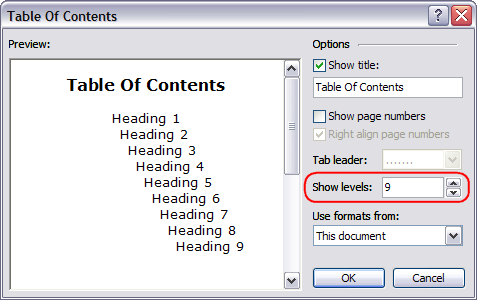
The TOC in the attached sample document was created in this way, so that it would include all 9 Heading levels. If you save this same document as EPUB in Atlantis, you get all 9 Headings in both the navigation pane and the inline TOC. Here is how this looks in the Sony Reader Library:
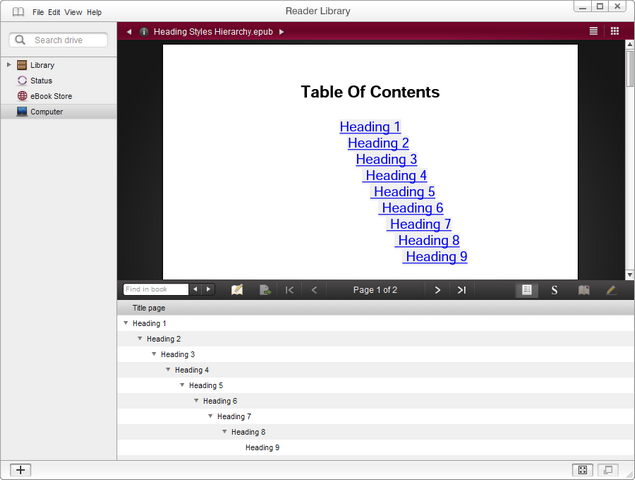
Now, your documents should always be built with a correct hierarchical structure of headings. And if you have paragraphs that you consider as Headings, you should apply any appropriate Heading style to them. This is the way to show your readers, and Atlantis, where each heading stands in the document hierarchy. In other words, each of your headings should be associated with a matching Heading style.
Here is from http://www.websitecriteria.com/Website_ ... archy.html:
Cheers,
Robert
First, when you create a TOC in Atlantis, you need to specify how many Heading levels you want to include in it:

The TOC in the attached sample document was created in this way, so that it would include all 9 Heading levels. If you save this same document as EPUB in Atlantis, you get all 9 Headings in both the navigation pane and the inline TOC. Here is how this looks in the Sony Reader Library:

Now, your documents should always be built with a correct hierarchical structure of headings. And if you have paragraphs that you consider as Headings, you should apply any appropriate Heading style to them. This is the way to show your readers, and Atlantis, where each heading stands in the document hierarchy. In other words, each of your headings should be associated with a matching Heading style.
Here is from http://www.websitecriteria.com/Website_ ... archy.html:
The most important piece of advice in the above text is this:Heading hierarchy
Do not use more than four heading levels on a Web page. No more than three levels is preferable.
1. main
....2. sub-heading
........3. sub-sub-heading
............4. sub-sub-sub-heading.
Users are very likely to become confused when more than four heading levels are used. It requires them to remember each heading and the relationship between the nested content on the page. This is counter to the way people read Web pages and usually assumes users have a far greater grasp of the content than they do.
If you believe a fifth heading level is required, simplify the heading hierarchy or consider splitting the content into multiple pages. For all short pieces of text use only the main and first sub-head. This is easier for the reader and helps the writer and editor to be more succinct.
Do not confuse the limit of four heading levels with the number of headings you can use on a page. There can be more than four headings on a page but the nesting should not go beyond four levels.
For example, this Web page uses four heading levels:
1. Website Writing Guide
....2. Web writing and presentation style
.......3. Heading hierarchy
...........4. Questions as headings
HTH.Do not confuse the limit of four heading levels with the number of headings you can use on a page. There can be more than four headings on a page but the nesting should not go beyond four levels.
Cheers,
Robert
- Attachments
-
- Heading Styles Hierarchy.docx
- (5.46 KiB) Downloaded 853 times
Hey Robert,
Thanks for all the detailed help. Really didn't need to go thru all that effort; could have just said check out this, click that, and that would have been enough. Save yourself some work.
I think I wasn't clear. I said Heading 1, 2, 3 (…) and meant those specific styles, the ones built in. Word, and Atlantis, let's you create any new style, and set an Outline Level. Check out the paragraph formatting, and you'll see you can set it for any paragraph.

That's what's missing from the TOC. Perhaps it's just an oversight (they do show in the Control Board) since it seems few use it.
Thanks for all the detailed help. Really didn't need to go thru all that effort; could have just said check out this, click that, and that would have been enough. Save yourself some work.
I think I wasn't clear. I said Heading 1, 2, 3 (…) and meant those specific styles, the ones built in. Word, and Atlantis, let's you create any new style, and set an Outline Level. Check out the paragraph formatting, and you'll see you can set it for any paragraph.

That's what's missing from the TOC. Perhaps it's just an oversight (they do show in the Control Board) since it seems few use it.
It was no trouble really.
You are correct. Atlantis has “Outline levels” for paragraphs. These paragraphs are referenced in the Outline shown in the “Headings” panel of the Control Board. But they are not picked up by the TOC.
There is a logic in this. If a paragraph is a Heading, why not include it in the hierarchy of Headings? And then why not assign a Heading style to it?
If you could use “Outline levels” to include items in the TOC, you might very well end up with items that would be some sort of second-class items, free electrons roaming in the TOC. The hierarchy of the document would not be so structured and obvious as it should be.
You are correct. Atlantis has “Outline levels” for paragraphs. These paragraphs are referenced in the Outline shown in the “Headings” panel of the Control Board. But they are not picked up by the TOC.
There is a logic in this. If a paragraph is a Heading, why not include it in the hierarchy of Headings? And then why not assign a Heading style to it?
If you could use “Outline levels” to include items in the TOC, you might very well end up with items that would be some sort of second-class items, free electrons roaming in the TOC. The hierarchy of the document would not be so structured and obvious as it should be.
Well, then that is something that differs from Word. You think it was intentional or was just forgotten? No big deal if you guys just missed it (since again I think it's not often used). Adding it would be nice.
The reason it's necessary is you could have many heading 3s, that vary in style throughout. In a long enough book, with varied content and accompanying styles, it can happen. Really, I need it!
Gary
The reason it's necessary is you could have many heading 3s, that vary in style throughout. In a long enough book, with varied content and accompanying styles, it can happen. Really, I need it!
Gary
It is intentional.
It runs against good document design to have Heading styles referring to the same level in the hierarchy of headings, but formatted differently. This is likely to confuse many people! The author might be the only one who really knows where each heading stands in the logical structure of the document. The specific formatting of a Heading (style) is what makes people identify its level automatically and immediately. If you use different formatting for headings of the same level, most people won’t know which level each of these paragraphs relates to.
This said, you can very well have paragraphs associated with the same Heading style (level), but having different formatting. This is usually frowned upon by purists, but if you want it you can have it.
The attached sample document illustrates how paragraphs associated with the same Heading style (level) can be formatted differently. I have applied specific extra formatting to 2 Heading 3 and 2 Heading 5 paragraphs in this document (this is so-called “direct additional formatting” or “non-styled” formatting):
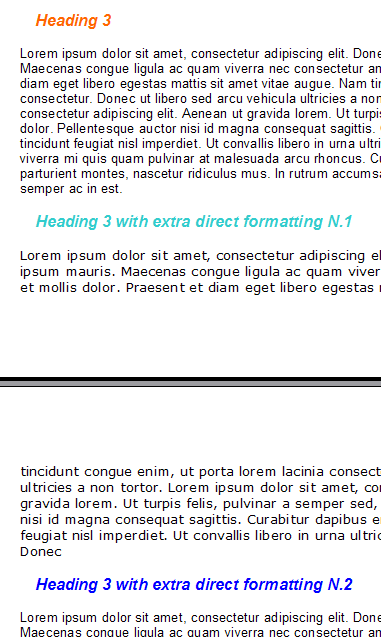
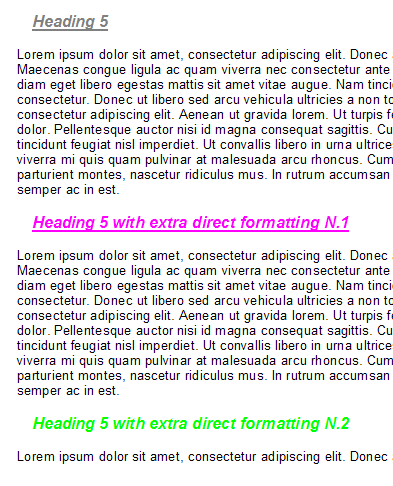
Now here is the corresponding TOC:
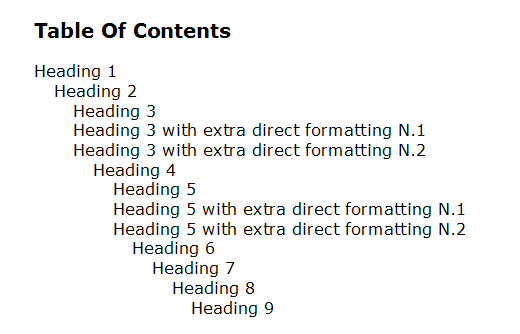
Note that this approach will inevitably make style changes very unpredictable, and document maintenance hell.
It runs against good document design to have Heading styles referring to the same level in the hierarchy of headings, but formatted differently. This is likely to confuse many people! The author might be the only one who really knows where each heading stands in the logical structure of the document. The specific formatting of a Heading (style) is what makes people identify its level automatically and immediately. If you use different formatting for headings of the same level, most people won’t know which level each of these paragraphs relates to.
This said, you can very well have paragraphs associated with the same Heading style (level), but having different formatting. This is usually frowned upon by purists, but if you want it you can have it.
The attached sample document illustrates how paragraphs associated with the same Heading style (level) can be formatted differently. I have applied specific extra formatting to 2 Heading 3 and 2 Heading 5 paragraphs in this document (this is so-called “direct additional formatting” or “non-styled” formatting):


Now here is the corresponding TOC:

Note that this approach will inevitably make style changes very unpredictable, and document maintenance hell.
- Attachments
-
- Heading Styles Hierarchy2.docx
- (5.09 KiB) Downloaded 855 times
Ugh. I see you're gonna make me work to convince you, eh?
Since you asked why not making a paragraph a (built-in) heading anyway, I could ask, why have the feature of setting an outline level for paragraphs, and even showing it in the Control Board?
I think if you look at enough books (or do enough book layout , you'll see it's use.). I can't imagine all the cases where people would use it, but for stuff I'm doing now… There was that thing I asked about recently? I turned that scanned book into an ePub. It had pretty simple formatting. Poems and essays were Heading 3 I think. In some cases, there was an included quote and/or dedication. In those cases, the style looked the same but just differed in space after, so the content itself remained spaced about the same. There were less than a dozen cases, so it was easy to manually fix.
I'm now doing a poetry anthology. There are cases where a poem might be multi part. Or it might even be untitled so what looks like Heading 3 is just a roman numeral (to denote work number), and in the table of contents, what shows up is the first line of the poem.
There are probably many other cases where people do this. I'm sure if you just sit in a bookstore and look around, you'll find 'em. Please please please consider it. I could fix it manually later, but in this case, there are hundreds of TOC entries that differ in styling. Even if they vary in 3 or 4 ways of how they look, there are hundreds of entries to manually change.
I haven't looked at Quark or InDesign in a long time. But I imagine, they work as I'd like. I'd wager any app (WordPerfect, Ami, who knows what else) that has been around for a long time (or was) does as well.
Other cases I can think of. Headings with sub headings immediately after. Consider a Heading 2, the first heading 3 (that comes immediately after a heading 2), has different spacing. Appendices and prefaces though normally heading 1 are often styled differently. I can probably find other examples but I think that makes sense?
Since you asked why not making a paragraph a (built-in) heading anyway, I could ask, why have the feature of setting an outline level for paragraphs, and even showing it in the Control Board?
I think if you look at enough books (or do enough book layout , you'll see it's use.). I can't imagine all the cases where people would use it, but for stuff I'm doing now… There was that thing I asked about recently? I turned that scanned book into an ePub. It had pretty simple formatting. Poems and essays were Heading 3 I think. In some cases, there was an included quote and/or dedication. In those cases, the style looked the same but just differed in space after, so the content itself remained spaced about the same. There were less than a dozen cases, so it was easy to manually fix.
I'm now doing a poetry anthology. There are cases where a poem might be multi part. Or it might even be untitled so what looks like Heading 3 is just a roman numeral (to denote work number), and in the table of contents, what shows up is the first line of the poem.
There are probably many other cases where people do this. I'm sure if you just sit in a bookstore and look around, you'll find 'em. Please please please consider it. I could fix it manually later, but in this case, there are hundreds of TOC entries that differ in styling. Even if they vary in 3 or 4 ways of how they look, there are hundreds of entries to manually change.
I haven't looked at Quark or InDesign in a long time. But I imagine, they work as I'd like. I'd wager any app (WordPerfect, Ami, who knows what else) that has been around for a long time (or was) does as well.
Other cases I can think of. Headings with sub headings immediately after. Consider a Heading 2, the first heading 3 (that comes immediately after a heading 2), has different spacing. Appendices and prefaces though normally heading 1 are often styled differently. I can probably find other examples but I think that makes sense?